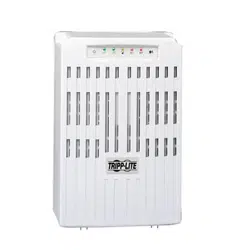Loading ...
Loading ...
Loading ...

9
Basic Operation
Accessory Slot: Remove the small cover panel from this slot to
install optional accessories to remotely monitor and control your
UPS. Refer to your accessory’s manual for installation instructions.
Contact Tripp Lite Customer Support at (773) 869-1234 for
more information, including a list of available SNMP, networking
management and connectivity products.
Output Breakers: Your UPS features one or more breakers that
protect your UPS from output overload. If one or more breakers
trip, remove some of the load on the circuit(s), then reset them by
pressing the breaker switch(es) in.
Battery Charge Level Switch (select models): Select models
feature a switch that controls the UPS system’s battery charge rate.
If you connect any external batteries, set the Battery Charge Level
Switch to the up position. This will increase your UPS’s charger
output so the additional batteries charge faster.
Note: the switch to the right of the Battery Charge Level Switch is
inactive and will not affect UPS operation regardless of its position.
CAUTION! DO NOT set the Battery Charge Level Switch to the
up position without an external battery connected. There is a
risk of damaging the UPS’s internal battery system.
Power Sensitivity Adjustment: This dial is normally set fully
counterclockwise, which enables the UPS to provide maximum
protection against waveform distortions in its AC input. When such
distortion occurs, the UPS will normally switch to providing PWM sine
wave power from its battery reserves for as long as the distortion
is present. In areas with poor utility power or where the UPS’s
input power comes from a backup generator, chronic waveform
distortion could cause the UPS to switch to battery too frequently,
draining its battery reserves. You may be able to reduce how often
your UPS switches to battery due to moderate waveform distortion
by experimenting with different settings for this dial. As the dial is
turned clockwise, the UPS becomes more tolerant of variations in its
input power’s AC waveform.
Note: The further the dial is adjusted clockwise, the greater the
degree of waveform distortion the UPS will allow to pass to connected
equipment. When experimenting with different settings for this dial,
operate connected equipment in a safe test mode so that the effect on
the equipment of any waveform distortions in the UPS’s output can be
evaluated without disrupting critical operations.
Charge Rate Setting
(when External Batteries
are not connected)
Charge Rate Setting
(when External Batteries
are connected)
DELAY
NORM
18-08-322-932245.indb 9 5/3/2019 1:44:55 PM
Loading ...
Loading ...
Loading ...
